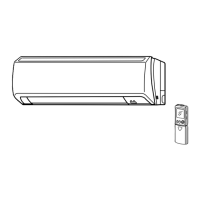
Do you have a question about the Mitsubishi Electric Mr.Slim MS-A09WA and is the answer not in the manual?
| Brand | Mitsubishi Electric |
|---|---|
| Model | Mr.Slim MS-A09WA |
| Category | Air Conditioner |
| Language | English |
Explanation of warning and caution marks used in the manual for safety.
Key symbols indicating do's and don'ts for safe operation and maintenance.
Critical safety precautions regarding electrical hazards, handling, and operation.
Identification and description of the parts of the indoor unit.
Identification and description of the parts of the outdoor unit.
Identification and description of the remote controller's buttons and display.
Instructions for inserting AAA alkaline batteries into the remote controller.
Procedure to set the current time on the remote controller for timer functions.
Guide to switching between Fahrenheit (°F) and Celsius (°C) display units.
Automatic mode adjusting operation based on room temperature.
Standard mode for cooling the room to a set temperature.
Mode for dehumidifying the room with mild cooling.
Mode to circulate air without cooling or dehumidifying.
How to operate the unit using the emergency switch on the indoor unit.
How to select fan speed settings: AUTO, Low, Medium, High.
How to set the vane position for optimal air distribution.
Procedure to start the Econo Cool mode for energy-saving cooling.
Explanation of the Econo Cool feature for comfortable energy-saving cooling.
Procedure to start the Powerful Cool mode for rapid cooling.
How to cancel the Powerful Cool mode manually or automatically.
Instructions for setting the unit to turn ON or OFF at a specific time.
How to increase or decrease the set timer time.
Procedure to cancel the set ON or OFF timer.
General guidelines and precautions for cleaning the air conditioner unit.
Steps to remove, clean, and reattach the front panel.
Instructions for cleaning the Anti-Allergy Enzyme Filter.
Instructions for cleaning the Catechin air filter.
Common symptoms and check points for the indoor unit.
Common symptoms and check points for the outdoor unit.
Common symptoms and check points for the remote controller.
Troubleshooting common airflow and sound-related problems.
Steps to prepare the unit for extended periods of non-use.
Checks required before resuming operation after long-term storage.
Guidance on selecting suitable locations for installation.
Locations that should be avoided for proper and safe installation.
Guidelines for electrical connections and circuit requirements.
Table detailing the operating temperature and humidity ranges.
